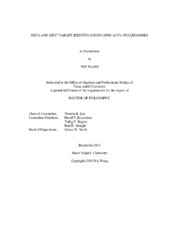| dc.description.abstract | For eukaryotes, DNA is maintained in the form of chromatin, which is comprised
of millions of repeated nucleosomes. Each nucleosome is assembled by wrapping 147
base pairs (bp) of DNA around a histone octamer containing 2 copies of H2A, H2B, H3
and H4. Histone residues undergo a plethora of post-translational modifications (PTM),
which have a great impact on the conformation and organization of chromatin and
eventually lead to significant epigenetic changes related to genetic events such as
transcription, replication and DNA repair.
SIRT6 and SIRT7 are the newest members of the Sirtuin deacetylase family.
With a unique NAD^+ dependent mechanism, Sirtuin enzymes remove histone lysine
acetylation and acylations. SIRT6 has been reported as a site-specific histone
deacetylase targeting H3K9 acetylation (H3K9ac) and H3K56 acetylation (H3K56ac).
SIRT7 was reported to be specific for H3K18 acetylation (H3K18ac). Compared to other
Sirtuin members, SIRT6 and SIRT7 exhibit very weak in vitro deacetylation activities on
acetyl-histones and acetyl-peptides, but become much more active on acetylnucleosomes.
However, all previous SIRT6 and SIRT7 histone targets were identified
using acetyl-peptides as substrates, raising the question whether new active sites could
be discovered if acetyl-nucleosomes were used as substrates
The main obstacle to biochemical study on nucleosomal level is the synthesis of
homogenous nucleosomes with site-specific PTM. In this work, using unnatural amino
acid incorporation technique, we synthesized homogenous histone H3 substrates with
iii
acylation at defined lysine sites, assembled them into acyl- nucleosomes, and screened
for targets of SIRT6 and SIRT7 with a novel fluorescence-based deacylation assay. As a
result, we discovered H3 K18 and H3 K27 as the new targets for SIRT6, H3 K36 as the
new target for SIRT7. The newly identified targets were confirmed in vitro using sitespecific
acetyl-nucleosomes, and in vivo using SIRT6 or SIRT7 overexpressed
mammalian cell model. Using Chip-Seq assay, H3K36ac was discovered to be
downregulated at specific gene promoters, nucleoli and telomeres. SIRT7 deacetylation
is activated by extranucleosomal DNA through its electrostatic bridging between histone
and enzyme. | en |


